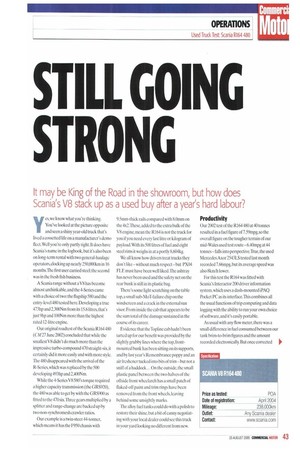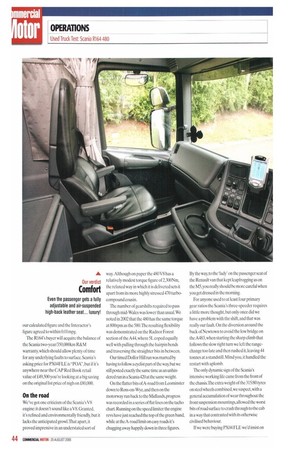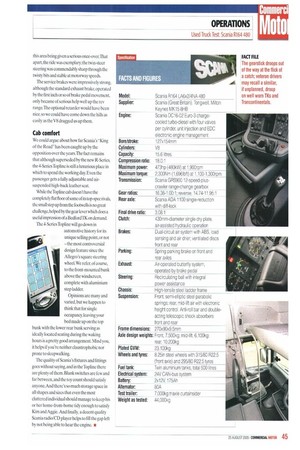STI LL GOING
Page 47

Page 48

Page 49

If you've noticed an error in this article please click here to report it so we can fix it.
STRONG
It may be King of the Road in the showroom, but how does Scania's V8 stack up as a used buy after a years hard labour?
Tes,we know what you're thinking. You've looked at the picture opposite and seen a shiny year-old truck that's lived a cossetted life on a manufacturer's demo fleet. Well you're only partly right. It does have Scania's name in the logbook, but it's also been on long-term rental with two general-haulage operators, clocking up nearly 250,000km in 16 months.The first user carried steel: the second was in the fresh fish business.
A Scania range without a V8 has become almost unthinkable, and the 4-Series came with a choice of two: the flagship 580 and the entry-level 480 tested here. Developing a true 473hp and 2,300Nm from its 15.6 litres, that's just 9hp and 100Nm more than the highest rated 12-litre engine.
Our original roadtest of the Scania R164 480 (CM 27 June 2002) concluded that while the smallest V8 didn't do much more than the impressive turbo-compound 470 straight-six, it certainly did it more easily and with more style. The 480 disappeared with the arrival of the R-Series, which was replaced by the 500 developing 493hp and 2,400Nm.
While the 4-Series V8 580's torque required a higher capacity transmission (the GRS920), the 480 was able to get by with the GRS900 as fitted to the 470 six.Three gears multiplied by a splitter and range-change are backed up by two non-synchromesh crawler ratios.
Our example is a twin-steer 44-tonner, which means it has the F950 chassis with 9.5mm-thick rails compared with 8.0mm on the 4x2.These, added to the extra bulk of the V8 engine, mean the R164 is not the truck for you if you need every last litre or kilogram of payload.With its 500 litres of fuel and eight steel rims it weighs in at a portly 8,604kg.
We all know how drivers treat trucks they don't like — without much respect — but PX04 FLE must have been well liked.The ashtray has never been used and the safety net on the rear bunk is still in its plastic bag.
There's some light scratching on the table top, a small sub-MoT-failure chip on the windscreen and a crack in the external sun visor. From inside the cab that appears to be the sum total of the damage sustained in the course of its career.
Evidence that the Topline cab hadn't been tamed up for our benefit was provided by the slightly grubby lines where the top, frontmounted bunk has been sitting on its supports, and by last year's Remembrance poppy and an air freshener tucked into bits of trim —but not a sniff of a haddock... On the outside, the small plastic panel between the two halves of the offside front wheelarch has a small patch of flaked-off paint and trim rings have been removed from the front wheels, leaving behind some unsightly marks.
The alloy fuel tanks could do with a polish to restore their shine, but a bit of canny negotiating with your local dealer could see this truck in your yard looking no different from new. Productivity Our 2002 test of the R164 480 at 40 tonnes resulted in a fuel figure of 7.59mpg, so the overall figure on the tougher terrain of our mid-Wales used test route-6.40mpg at 44 tonnes— falls into perspective. True, the used Mercedes Axor 2543LS tested last month recorded 7.66mpg, but its average speed was also 8km/h lower.
For this test the R164 was fitted with Scania's Interactor 200 driver information system.which uses a dash-mounted iPAQ Pocket PC as its interface. This combines all the usual functions of trip computing and data logging with the ability to run your own choice of software, and it's easily portable.
As usual with any flow meter, there was a small difference in fuel consumed between our tank brim-to-brim figures and the amount recorded electronically. But once corrected our calculated figure and the lnteractor's figure agreed to within 0.01mpg.
The R164's buyer will acquire the balance of the Scania two-year/350,000km R&M warranty,which should allow plenty of time for any underlying faults to surface. Scania's asking price for PX04FLE is "POA", but if it's anywhere near the CAP Red Book retail value of £49,500 you're looking at a big saving on the original list price of nigh on £80,000.
On the road
We've got one criticism of the Scania's V8 engine: it doesn't sound like a V8. Granted, it's refined and environmentally friendly, hut it lacks the anticipated growl.That apart, it proved impressive in an understated sort of way. Although on paper the 480 V8 has a relatively modest torque figure of 2,3()0Nm, the relaxed way in which it is delivered sets it apart from its more highly stressed 470 turbocompound cousin.
The number of gearshifts required to pass through mid-Wales was lower than usual.We noted in 2002 that the 480 has the same torque at 800rpm as the 580.1he resulting flexibility was demonstrated on the Radnor Forest section of the A44, where 5L coped equally well with pulling through the hairpin bends and traversing the straighter bits in between.
Our timed Dolfor Hill run was marred by having to follow a cyclist part of the way,but we still posted exactly the same time as an unhindered run in a Scania 420 at the same weight.
On the flatter bits of A-road from Leominster down to Ross-on-Wye, and then on the motorway run back to the Midlands, progress was recorded in a series of flat lines on the tacho chart. Running on the speed limiter the engine revs have just reached the top of the green band, while at the A-road limit on easy roads it's chugging away happily down in three figures. By the way,to the 'lady' on the passenger seat of the Renault van that kept leapfrogging us on the M5, you really should be more careful when you get dressed in the morning.
For anyone used to at least four primary gear ratios the Scania's three-speeder requires a little more thought, but only once did we have a problem with the shift, and that was really our fault. On the diversion around the back of Newtown to avoid the low bridge on the A483, when starting the sharp climb that follows the slow right turn we left the rangechange too late and then rushed it, leaving 44 tonnes at a standstill. Mind you, it handled the restart with aplomb.
The only dynamic sign of the Scania's intensive working life came from the front of the chassis The extra weight of the 315/80 tyres on steel wheels combined, we suspect, with a general accumulation of wear throughout the front suspension mountings,allowed the worst bits of road surface to crash through to the cab in a way that contrasted with its otherwise civilised behaviour.
If we were buying PX04 FLE we'd insist on this area being given a serious once-over.That apart, the ride was exemplary; the twin-steer steering was commendably sharp through the twisty bits and stable at motorway speeds.
The service brakes were impressively strong, although the standard exhaust brake, operated by the first inch or so of brake pedal movement, only became of serious help well up the rev range.The optional retarder would have been nice, so we could have come down the hills as easily as the V8 dragged us up them.
Cab comfort
We could argue about how far Scania's "King of the Road" has been caught up by the opposition over the years. The fact remains that although superseded by the new R-Series, the 4-Series Topline is still a luxurious place in which to spend the working day. Even the passenger gets a fully adjustable and airsuspended high-back leather seat.
While theTopline cab doesn't have the completely flat floor of some of its top-spec rivals, the small step up from the footwells is no great challenge, helped by the gear lever which does a useful impression of a Bedford TK on demand.
The 4-Series Topline will go down in automotive history for its unique selling point, or not — the most controversial design feature since the Allegro's square steering wheel. We refer, of course, to the front-mounted bunk above the windscreen, complete with aluminium step ladder.
Opinions are many and varied, but we happen to think that for single occupancy, leaving your bed made up on the top bunk with the lower rear bunk serving as ideally located seating during the waking hours is a pretty good arrangement. Mind you, it helps if you're neither claustrophobic nor prone to sleepwalking.
The quality of Scania's fixtures and fittings goes without saying, and in the Topline there are plenty of them. Blank switches are few and far between, and the toy count should satisfy anyone. And there's so much storage space in all shapes and sizes that even the most cluttered individual should manage to keep his or her home-from-home tidy enough to satisfy Kim and Aggie. And finally, a decent quality Scania radio/CD player helps to fill the gap left by not being able to hear the engine. •






























































































































































































